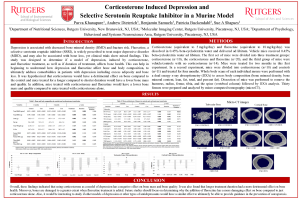Khanapure, Purva: Corticosterone Induced Depression and Selective Serotonin Reuptake Inhibitor in a Murine Model

Title: Corticosterone Induced Depression and Selective Serotonin Reuptake Inhibitor in a Murine Model
Name: Purva Khanapure
Major: Biological Sciences
School affiliation: Honors College, School of Arts and Sciences
Programs: Aresty – Research or Conference Funding Recipient, Honors College Capstone
Other contributors: Sue Shapses, Patricia Buckendahl, Benjamin Samuels, and Andrew Dieterich
Abstract: Depression is associated with decreased bone mineral density (BMD) and fracture risk. Fluoxetine, a selective serotonin reuptake inhibitor, is widely prescribed to treat major depressive disorder, and may also be associated with bone loss, yet clinical trials show mixed findings. This study was designed to determine if a model of depression, induced by corticosterone, and fluoxetine treatment, as well as if duration of treatment, affects bone health. To address this question, we used C57BL/6J male mice (~two months of age) in two experiments for two different durations. In group 1, mice were randomly assigned to one of three subgroups: corticosterone (Cort) (n=10), corticosterone and fluoxetine (Flx) (n=20), and a control without any treatment (n=14) over a period of two months. In group 2 (longer-duration), mice were randomly assigned to corticosterone (n=18) and controls (n=11) and were treated for four months. Whole body scans and individual bones, following dissection, were analyzed using a dual energy x-ray absorptiometry for body composition and BMD. Micro-computed tomography analysis of bone samples assessed parameters of bone quality. Results indicated that mice exposed to corticosterone compared to controls had lower total bone mineral content (BMC), femur BMD, femur BMC, and lean body mass, but greater body fat in both experiments (p<0.05). Mice treated for a longer duration had lower BMC and tibia BMD, but higher total BMD (p<0.05). It was also found that in mice exposed to corticosterone and for a longer duration, a majority of cortical variables decreased while, unexpectedly, most trabecular variables increased (p<0.05). Two-way ANOVA (treatment x duration) indicated that corticosterone treatment reduced percent bone volume (BV/TV) in a similar manner whether treated for two or four months. Not surprisingly, when fluoxetine was administered, bone was further compromised with BV/TV, trabecular number (Tb.N), femur BMD, bone area (B.Ar.), and total area (T.Ar) decreasing and trabecular separation (Tb.Sp) increasing. One limitation of this study, however, is that corticosteroids have direct negative effects on bone, independent of its effects on depression, and so other models of depression would be useful to explore to determine the impact of depression on bone. Overall, these findings suggest that there is significant bone loss using this model of depression, and bone is further compromised with fluoxetine treatment.